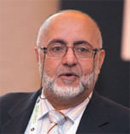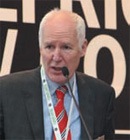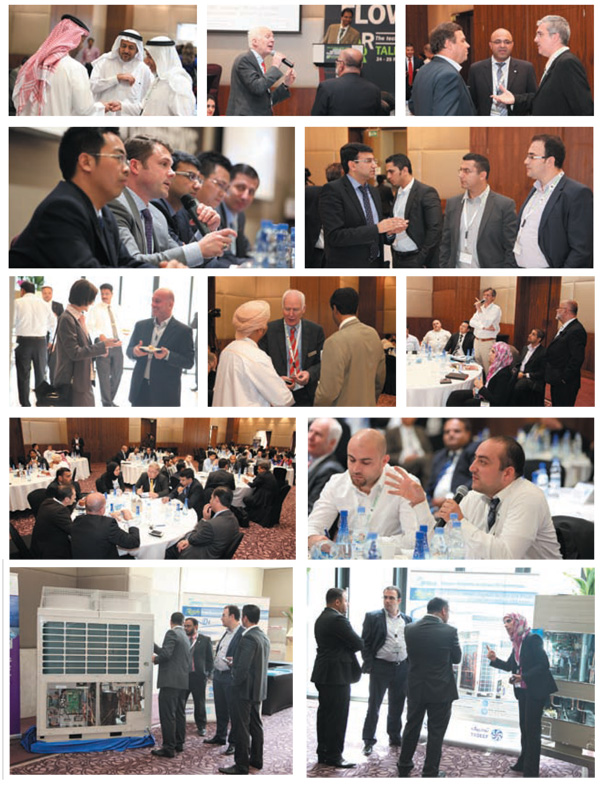Recommendations from the participants and delegates at the 1st Annual Middle East VRF Conference revealed an intensified call for the formation of a regional industry association and transparency via third-party certification. We bring you the third and last installment of our in-depth report.
Recommendations from the participants and delegates at the 1st Annual Middle East VRF Conference revealed an intensified call for the formation of a regional industry association and transparency via third-party certification. We bring you the third and last installment of our in-depth report.
Day two of the 1st Annual Middle East VRF Conference saw a cluster discussion, in which the participants and delegates, including representatives from government bodies and agencies, the industry, the media and the academia, exchanged ideas, insights and perspectives on some of the key industry issues and views posited during the two-day conference.
Based on the discussion, the participants were asked to draft recommendations on a range of topics, including the formation of an association for VRF stakeholders, standardisation of codes and regulations for VRF system certification, information dissemination among VRF system manufacturers and training for installation and maintenance personnel.
One of the key issues to emerge from a presentation by Ghaleb Abusaa, CEO, The Three Factors Company (en3 Solutions), delivered prior to the cluster discussion, was that district cooling service providers were able to take a huge share in the Dubai market in less than 15 years, because they managed to set up an association dedicated to the industry, which also sells and educates people about district cooling as a technology. Abusaa, then, threw a challenge at the VRF industry and called upon the stakeholders present to spearhead a similar formation for VRF systems. Abusaa said: “Those who are eager to see VRF systems take a bigger share of the market should join hands and keep personal competition aside for the benefit of the industry itself.”
Endorsing this view, recommendations from the participants established the fact that industry representation was missing in the region and, therefore, the formation of an association would give VRF stakeholders a “voice”. In line with this, Moan Abraham of Johnson Controls shared the information that there would soon be a GCC-based organisation of air conditioning manufacturers and suppliers, and that bylaws were currently being drawn out. He pointed out that forming an association with a committee exclusively dedicated to VRF was more feasible than forming a completely independent VRF association.
Refrigeration expert Yaqoub Al Matouq, speaking during the cluster discussion, also contributed some valuable information on the subject of forming of an association, saying that during a meeting with AHRI, industry stakeholders present agreed to set up an organisation, though the location of the headquarters could not be decided upon. Therefore, the parties present resolved that AHRI would remotely run the association for three years, and then, after the necessary legal framework was ready, it would hand over the association to the GCC countries, which would then choose the location of the headquarters.
Another key point that came out of the exercise was that the efficiency of VRF systems had not yet been proven owing to the lack of standards in the technology’s certification process. “We need a third-party certification system to cleanse this industry,” said Peck Zhao, Marketing Manager, Midea. “Every manufacturer’s product should be governed by only one regulation. At present, everyone’s declaration is under different rules, and we need only one regulation,” he added.
The participants were of the opinion that VRF manufacturers and suppliers were providing information about their products under different conditions or partial load percentages. They recognised the need to unify the standards and codes and suggested that the governments had to formulate regulations so that VRF manufacturers would be able to calculate their data based on some specific conditions. They were also unanimous in saying that data coming from manufacturers should be supported by third-party certification.
The recommendations also reflected the desire of the participants to see a collaborative effort among VRF stakeholders to promote the technology, test their respective systems and present the results to the public in order to promote the culture of transparency within the industry.
In this exclusive in-depth coverage of the conference, we also bring you excerpts from some of the presentations made.
 Xiucheng JiSenior Engineering Manager for VRF Systems, Johnson Controls Asia Engineering Centre, China“So, how can we achieve high efficiency? The most important thing is the compressor. For this product, we used a special DC inverter compressor to improve part-load efficiency…. Everyone knows that over-compression loss is very big, particularly in part-load. You will see that this product provides over 12% efficiency improvement at 25% part-load test point, and over nine per cent efficiency improvement at 50% part-load test point….“In this product, we also used BLDC fan motor. With the BLDC motor, motor efficiency is up to 85% at full-load. A BLDC motor at full-load will reduce about 33% in power consumption.“High-efficiency heat exchanger is especially important for high-ambient temperature designs. Since the pressure is very high in systems running in high-ambient temperatures, if the heat exchanger is not good, we will unload the compressor….“The discharge pressure needs to be controlled in systems running in high-ambient temperatures, because, if it is not controlled precisely, the compressor may unload, so the deration will be very high…. The discharge temperature control is also very important, because sometimes the system will unload, the compressor cannot run in high-speed, because we need to protect the compressor temperature…. We also need to consider using high-performance coils in systems running in high-ambient temperatures, to lower the high pressure and to let the system run at high speed with high performance, so the deration will be low.” Xiucheng JiSenior Engineering Manager for VRF Systems, Johnson Controls Asia Engineering Centre, China“So, how can we achieve high efficiency? The most important thing is the compressor. For this product, we used a special DC inverter compressor to improve part-load efficiency…. Everyone knows that over-compression loss is very big, particularly in part-load. You will see that this product provides over 12% efficiency improvement at 25% part-load test point, and over nine per cent efficiency improvement at 50% part-load test point….“In this product, we also used BLDC fan motor. With the BLDC motor, motor efficiency is up to 85% at full-load. A BLDC motor at full-load will reduce about 33% in power consumption.“High-efficiency heat exchanger is especially important for high-ambient temperature designs. Since the pressure is very high in systems running in high-ambient temperatures, if the heat exchanger is not good, we will unload the compressor….“The discharge pressure needs to be controlled in systems running in high-ambient temperatures, because, if it is not controlled precisely, the compressor may unload, so the deration will be very high…. The discharge temperature control is also very important, because sometimes the system will unload, the compressor cannot run in high-speed, because we need to protect the compressor temperature…. We also need to consider using high-performance coils in systems running in high-ambient temperatures, to lower the high pressure and to let the system run at high speed with high performance, so the deration will be low.” |
 Peck ZhaoMarketing Manager, Midea Commercial Air Conditioner, Global Sales Company“Digital scroll technology allows seamless capacity delivery from 10% to 100% without gap. In addition, this compressor can control humidity very precisely, because the whole system, the discharge temperature and suction temperature are very stable. This is a mechanical movement compressor, so there is no harmony wave created and no interference caused to other equipment….“The digital scroll compressor has a low-side design, making it suitable for high-ambient temperature operations, like in the Middle East. The low-side design means that the motor is always working in low temperatures and it is close to the suction gas. This is different from how inverter high-side design compressors operate. So, there is no risk in high-ambient temperatures. That is why the digital scroll VRF can work to up to 54°C.“The digital scroll technology has the ability to produce an output capacity that exactly meets the demand. It can also better control humidity, even at low capacity. It also has a wide capacity range, has a longer piping and a higher vertical difference. It is a simplified system, which means fewer components, less PCBs and less service costs.” Peck ZhaoMarketing Manager, Midea Commercial Air Conditioner, Global Sales Company“Digital scroll technology allows seamless capacity delivery from 10% to 100% without gap. In addition, this compressor can control humidity very precisely, because the whole system, the discharge temperature and suction temperature are very stable. This is a mechanical movement compressor, so there is no harmony wave created and no interference caused to other equipment….“The digital scroll compressor has a low-side design, making it suitable for high-ambient temperature operations, like in the Middle East. The low-side design means that the motor is always working in low temperatures and it is close to the suction gas. This is different from how inverter high-side design compressors operate. So, there is no risk in high-ambient temperatures. That is why the digital scroll VRF can work to up to 54°C.“The digital scroll technology has the ability to produce an output capacity that exactly meets the demand. It can also better control humidity, even at low capacity. It also has a wide capacity range, has a longer piping and a higher vertical difference. It is a simplified system, which means fewer components, less PCBs and less service costs.” |
 Sana HamdaniStrategic Marketing Engineer, Daikin McQuay“The three main components of the total lifecycle cost are investment cost, running cost, and maintenance cost….“The difference in investment cost between a chiller and a VRF is low; it is only six per cent. If you will investigate, the main component of the investment cost is the main equipment – which shows that a VRF system is more expensive than a chiller. But, for a chiller system, you need to add other components, like pumps and cooling towers, which will increase your investment cost in equipment. The water/refrigerant costs are more or less the same. For the controls, most of the time, a chiller will require more costly controls compared to VRF systems…. There is also a possible infrastructure cost increase, because with the chiller, you may have to reinforce your roof or you might have to invest in electricity, for example.“For the running cost, when you compare a VRV with a chiller, you may realise savings of 50% in electricity, but when you compare it with a packaged non-inverter ducted unit, you may have up to 83% savings in electricity consumption….“The running cost is simply the electricity consumption multiplied by electricity cost. But how do you simulate electricity consumption? Electricity consumption will depend, first of all, on your operating load, and your real-life operating load will depend on the outdoor temperature. The second element will be the representation of efficiency you will take. The last point, of course, is the efficiency of the technology you offer….“We need to adjust temperature points and weight to better fit the Middle East climate. We need to develop a formula that is suitable for us and that is common for the whole GCC [region], which will allow us to compare in a fair basis the efficiency of different systems. Sana HamdaniStrategic Marketing Engineer, Daikin McQuay“The three main components of the total lifecycle cost are investment cost, running cost, and maintenance cost….“The difference in investment cost between a chiller and a VRF is low; it is only six per cent. If you will investigate, the main component of the investment cost is the main equipment – which shows that a VRF system is more expensive than a chiller. But, for a chiller system, you need to add other components, like pumps and cooling towers, which will increase your investment cost in equipment. The water/refrigerant costs are more or less the same. For the controls, most of the time, a chiller will require more costly controls compared to VRF systems…. There is also a possible infrastructure cost increase, because with the chiller, you may have to reinforce your roof or you might have to invest in electricity, for example.“For the running cost, when you compare a VRV with a chiller, you may realise savings of 50% in electricity, but when you compare it with a packaged non-inverter ducted unit, you may have up to 83% savings in electricity consumption….“The running cost is simply the electricity consumption multiplied by electricity cost. But how do you simulate electricity consumption? Electricity consumption will depend, first of all, on your operating load, and your real-life operating load will depend on the outdoor temperature. The second element will be the representation of efficiency you will take. The last point, of course, is the efficiency of the technology you offer….“We need to adjust temperature points and weight to better fit the Middle East climate. We need to develop a formula that is suitable for us and that is common for the whole GCC [region], which will allow us to compare in a fair basis the efficiency of different systems.
“In principle, seasonal efficiency is a much better representation of efficiency, because this will be in line with your real-life operation condition. However, the “bin” hours, the load and the weight have to be adjusted to reflect our regional conditions. “A VRV system is more expensive to maintain than a non-inverter packaged unit, but can be cheaper compared to chillers. Regular maintenance can ensure optimal energy efficiency and can reduce total cost of ownership. Therefore, it is important to take a more proactive approach in maintenance, which may be costly at the beginning, but may offer a quick return on investment.” |
 Amjad Abu AlikaAcademy Manager, LG Electronics“LG has taken the initiative and has invested in infrastructure in Dubai to provide different kinds of training. Attending training sessions in the LG Academy in Dubai is free for everyone. We can provide training for engineers in design and installation and for technicians in installation and servicing. We have trained, from 2003, 9,000 participants, and we are expecting 700 more participants in 2013. The training centre is located in Jebel Ali, and it is furnished with facilities and practical and display rooms.“In 2012, we had a special programme to certify the installing companies in the market. We invited 10 of their staff members to attend a 10-day training. In the last step, they had to install the system by themselves in the Academy, then, we certified them…. So, whenever you deal with them, you know you are on the safe side….” Amjad Abu AlikaAcademy Manager, LG Electronics“LG has taken the initiative and has invested in infrastructure in Dubai to provide different kinds of training. Attending training sessions in the LG Academy in Dubai is free for everyone. We can provide training for engineers in design and installation and for technicians in installation and servicing. We have trained, from 2003, 9,000 participants, and we are expecting 700 more participants in 2013. The training centre is located in Jebel Ali, and it is furnished with facilities and practical and display rooms.“In 2012, we had a special programme to certify the installing companies in the market. We invited 10 of their staff members to attend a 10-day training. In the last step, they had to install the system by themselves in the Academy, then, we certified them…. So, whenever you deal with them, you know you are on the safe side….” |
 Ghaleb AbusaaCEO, The Three Factors Company (en3 Solutions)“I like to see a group introduced to the table that says ‘VRF systems’. To do that, we need to know the approximate tonnage or the percentage in the market and for the manufacturers to give us an approximate average figure of power consumption per tonne. That way, we could show the information in comparison to other systems. This is on the shoulder of the manufacturers….“Why are we always saying ‘district cooling is better!’ or ‘VRF is better!’? Look at the 90% to 98% of the air conditioning market, which is dominated by very bad inefficient equipment: the direct expansion and standard small chillers and room air conditioners with split AC units. Let us increase the share of VRF and district cooling on the account of the non-efficient equipment….“How was district cooling able to dominate and take a huge share in this Dubai market in less than 15 years? Because [the service providers] were planning properly and they managed to have an association that is dedicated to the market and sell and educate people about district cooling. Why not do something like that for the VRF systems? Are we willing to form an association for the VRF industry, similar to that of the district cooling and district energy?“Those who are eager to see the VRF systems take a bigger share of the market should join hands and keep the personal competition aside for the benefit of the industry itself…. Ghaleb AbusaaCEO, The Three Factors Company (en3 Solutions)“I like to see a group introduced to the table that says ‘VRF systems’. To do that, we need to know the approximate tonnage or the percentage in the market and for the manufacturers to give us an approximate average figure of power consumption per tonne. That way, we could show the information in comparison to other systems. This is on the shoulder of the manufacturers….“Why are we always saying ‘district cooling is better!’ or ‘VRF is better!’? Look at the 90% to 98% of the air conditioning market, which is dominated by very bad inefficient equipment: the direct expansion and standard small chillers and room air conditioners with split AC units. Let us increase the share of VRF and district cooling on the account of the non-efficient equipment….“How was district cooling able to dominate and take a huge share in this Dubai market in less than 15 years? Because [the service providers] were planning properly and they managed to have an association that is dedicated to the market and sell and educate people about district cooling. Why not do something like that for the VRF systems? Are we willing to form an association for the VRF industry, similar to that of the district cooling and district energy?“Those who are eager to see the VRF systems take a bigger share of the market should join hands and keep the personal competition aside for the benefit of the industry itself…. |
 Erick MelquiondManaging Director, Eurovent Certification System“Our principle is that we need to be a third party and we have to be independent. We are relying on third-party labs. We are using 14 different labs in Europe, and depending on the product and on the knowledge, we will concentrate all our products from all over the world in one single lab…. The bottom line of this is that you have very precise and comparable data of a product from one manufacturer to another. This is where the value is.“Our certification is on a voluntary basis. We don’t have a regulation anywhere telling anybody that you have to be Eurovent-certified. Some people will say, especially from the government, that if its voluntary, it is not going to work, and that we should make it mandatory. Well, try with your kids – the difference between “you have to do this” and “maybe it is interesting to do it”. You will a much better chance of success if you give a choice. This is what we do….“Testing conditions do not really reflect the everyday use of the product. So, you are going to tell me: ‘Well, what we are doing is useless!’ Not really, because at least all the products are being tested in the same conditions, so then you can compare. Then, you draw your conclusion.” Erick MelquiondManaging Director, Eurovent Certification System“Our principle is that we need to be a third party and we have to be independent. We are relying on third-party labs. We are using 14 different labs in Europe, and depending on the product and on the knowledge, we will concentrate all our products from all over the world in one single lab…. The bottom line of this is that you have very precise and comparable data of a product from one manufacturer to another. This is where the value is.“Our certification is on a voluntary basis. We don’t have a regulation anywhere telling anybody that you have to be Eurovent-certified. Some people will say, especially from the government, that if its voluntary, it is not going to work, and that we should make it mandatory. Well, try with your kids – the difference between “you have to do this” and “maybe it is interesting to do it”. You will a much better chance of success if you give a choice. This is what we do….“Testing conditions do not really reflect the everyday use of the product. So, you are going to tell me: ‘Well, what we are doing is useless!’ Not really, because at least all the products are being tested in the same conditions, so then you can compare. Then, you draw your conclusion.” |

Copyright © 2006-2025 - CPI Industry. All rights reserved.